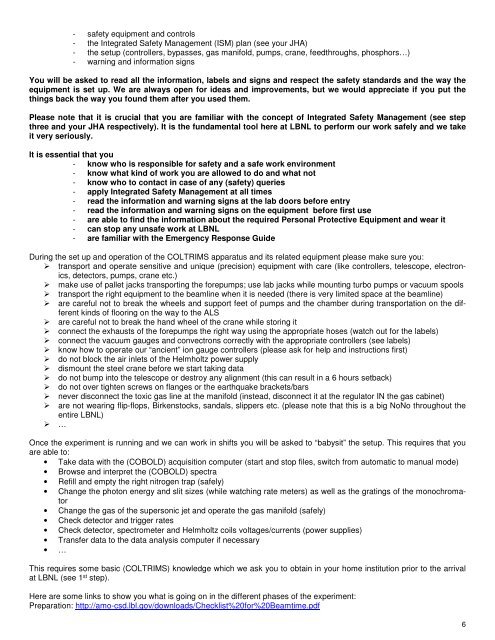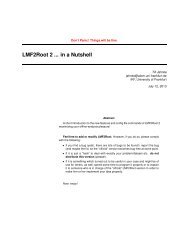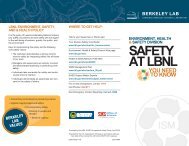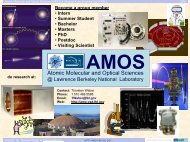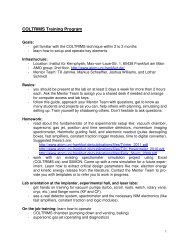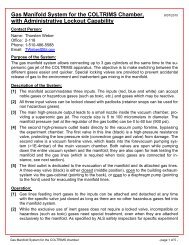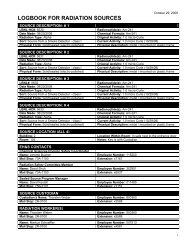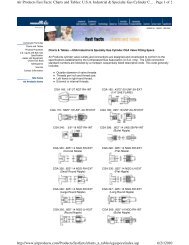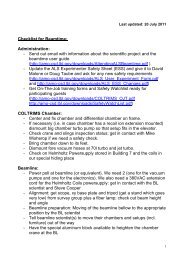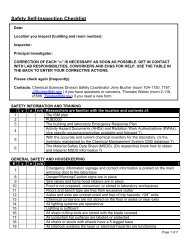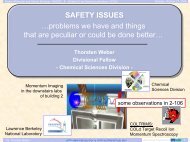So you want to attend a COLTRIMS beamtime - AMOS Experiment ...
So you want to attend a COLTRIMS beamtime - AMOS Experiment ...
So you want to attend a COLTRIMS beamtime - AMOS Experiment ...
You also want an ePaper? Increase the reach of your titles
YUMPU automatically turns print PDFs into web optimized ePapers that Google loves.
- safety equipment and controls<br />
- the Integrated Safety Management (ISM) plan (see <strong>you</strong>r JHA)<br />
- the setup (controllers, bypasses, gas manifold, pumps, crane, feedthroughs, phosphors…)<br />
- warning and information signs<br />
You will be asked <strong>to</strong> read all the information, labels and signs and respect the safety standards and the way the<br />
equipment is set up. We are always open for ideas and improvements, but we would appreciate if <strong>you</strong> put the<br />
things back the way <strong>you</strong> found them after <strong>you</strong> used them.<br />
Please note that it is crucial that <strong>you</strong> are familiar with the concept of Integrated Safety Management (see step<br />
three and <strong>you</strong>r JHA respectively). It is the fundamental <strong>to</strong>ol here at LBNL <strong>to</strong> perform our work safely and we take<br />
it very seriously.<br />
It is essential that <strong>you</strong><br />
- know who is responsible for safety and a safe work environment<br />
- know what kind of work <strong>you</strong> are allowed <strong>to</strong> do and what not<br />
- know who <strong>to</strong> contact in case of any (safety) queries<br />
- apply Integrated Safety Management at all times<br />
- read the information and warning signs at the lab doors before entry<br />
- read the information and warning signs on the equipment before first use<br />
- are able <strong>to</strong> find the information about the required Personal Protective Equipment and wear it<br />
- can s<strong>to</strong>p any unsafe work at LBNL<br />
- are familiar with the Emergency Response Guide<br />
During the set up and operation of the <strong>COLTRIMS</strong> apparatus and its related equipment please make sure <strong>you</strong>:<br />
transport and operate sensitive and unique (precision) equipment with care (like controllers, telescope, electronics,<br />
detec<strong>to</strong>rs, pumps, crane etc.)<br />
make use of pallet jacks transporting the forepumps; use lab jacks while mounting turbo pumps or vacuum spools<br />
transport the right equipment <strong>to</strong> the beamline when it is needed (there is very limited space at the beamline)<br />
are careful not <strong>to</strong> break the wheels and support feet of pumps and the chamber during transportation on the different<br />
kinds of flooring on the way <strong>to</strong> the ALS<br />
are careful not <strong>to</strong> break the hand wheel of the crane while s<strong>to</strong>ring it<br />
connect the exhausts of the forepumps the right way using the appropriate hoses (watch out for the labels)<br />
connect the vacuum gauges and convectrons correctly with the appropriate controllers (see labels)<br />
know how <strong>to</strong> operate our “ancient” ion gauge controllers (please ask for help and instructions first)<br />
do not block the air inlets of the Helmholtz power supply<br />
dismount the steel crane before we start taking data<br />
do not bump in<strong>to</strong> the telescope or destroy any alignment (this can result in a 6 hours setback)<br />
do not over tighten screws on flanges or the earthquake brackets/bars<br />
never disconnect the <strong>to</strong>xic gas line at the manifold (instead, disconnect it at the regula<strong>to</strong>r IN the gas cabinet)<br />
are not wearing flip-flops, Birkens<strong>to</strong>cks, sandals, slippers etc. (please note that this is a big NoNo throughout the<br />
entire LBNL)<br />
…<br />
Once the experiment is running and we can work in shifts <strong>you</strong> will be asked <strong>to</strong> “babysit” the setup. This requires that <strong>you</strong><br />
are able <strong>to</strong>:<br />
• Take data with the (COBOLD) acquisition computer (start and s<strong>to</strong>p files, switch from au<strong>to</strong>matic <strong>to</strong> manual mode)<br />
• Browse and interpret the (COBOLD) spectra<br />
• Refill and empty the right nitrogen trap (safely)<br />
• Change the pho<strong>to</strong>n energy and slit sizes (while watching rate meters) as well as the gratings of the monochroma<strong>to</strong>r<br />
• Change the gas of the supersonic jet and operate the gas manifold (safely)<br />
• Check detec<strong>to</strong>r and trigger rates<br />
• Check detec<strong>to</strong>r, spectrometer and Helmholtz coils voltages/currents (power supplies)<br />
• Transfer data <strong>to</strong> the data analysis computer if necessary<br />
• …<br />
This requires some basic (<strong>COLTRIMS</strong>) knowledge which we ask <strong>you</strong> <strong>to</strong> obtain in <strong>you</strong>r home institution prior <strong>to</strong> the arrival<br />
at LBNL (see 1 st step).<br />
Here are some links <strong>to</strong> show <strong>you</strong> what is going on in the different phases of the experiment:<br />
Preparation: http://amo-csd.lbl.gov/downloads/Checklist%20for%20Beamtime.pdf<br />
6


